Articles in the News Archives Category
Satellite and rocket-component builder OHB AG on Aug. 14 said it should know by late September whether the tests of its first Galileo satellites are proceeding well enough to permit their delivery later this year.
TI Asahi Co., Ltd. and Zoller + Froehlich GmbH have signed OEM agreement for exclusive distribution worldwide of PENTAX branded 3D scanners by TI Asahi Co., Ltd. Under the agreement, Zoller + Froehlich GmbH will OEMsupply PENTAX branded high-precision, state of art 3D and 2D scanners…
The US Department of Homeland Security has released a summary report on its evaluation of the risks to US critical infrastructure from GPS disruptions. The report states, “US critical infrastructure sectors are increasingly at risk from a growing dependency on GPS for positioning, navigation, and timing (PNT) services.
A European-Union funded consortium invites companies and public agencies from North Africa and the Middle East to submit ideas for extending Galileo GNSS and EGNOS use in the region. Eligible ideas could be for a small pilot project or research study, a technical training plan, and/or a publication or article.
Mercedes-Benz Research & Development North America (MBRDNA) is working on a way to take advantage of the Google’s newest GPS-equipped device: Google Glass.
Space Exploration Technologies was awarded a launch reservation contract with MacDonald, Dettwiler and Associates Ltd. (MDA) to support the largest space program to date in Canada, carrying the three satellites to orbit that will make up the RADARSAT Constellation Mission (RCM) on a Falcon 9 rocket in 2018. RCM is a three satellite
The National Geographic Institute (IGN), the mapping agency of Peru, has launched a project for digitisation of national cartography. The idea of the project is to have a high precision data in order to contribute to the growth of public and private investments that can benefi t from this updated mapping information.
NavCom Technology, Inc has announced the release of new software for its Sapphire-based receivers, including the SF-3050, SF-3040, and LANDPAK. The multi-frequency GNSS (GPS+GLONASS) receivers are now capable of supporting NavCom’s new StarFire Rapid Recovery feature, which allows users to quickly regain StarFire accuracy after short…
Russia recently launched a civil remote sensing satellite aboard a Soyuz rocket, lofting a spacecraft with a modernized high-resolution digital camera to collect imagery of Earth for Russian government. The images will be used by emergency personnel, environmental scientists, urban…
Nokia has announced some details on the HERE Venue Maps available for Nokia Lumia devices and Bing Maps. It now features 49,000 buildings in 45 countries. This doesn’t only include shopping malls, but also stadiums, theme parks, historic streets, or other outdoor spaces, such as Carnaby Village and golf clubs. Nokia claims to create precise Venue…










 (5.00 out of 5)
(5.00 out of 5)